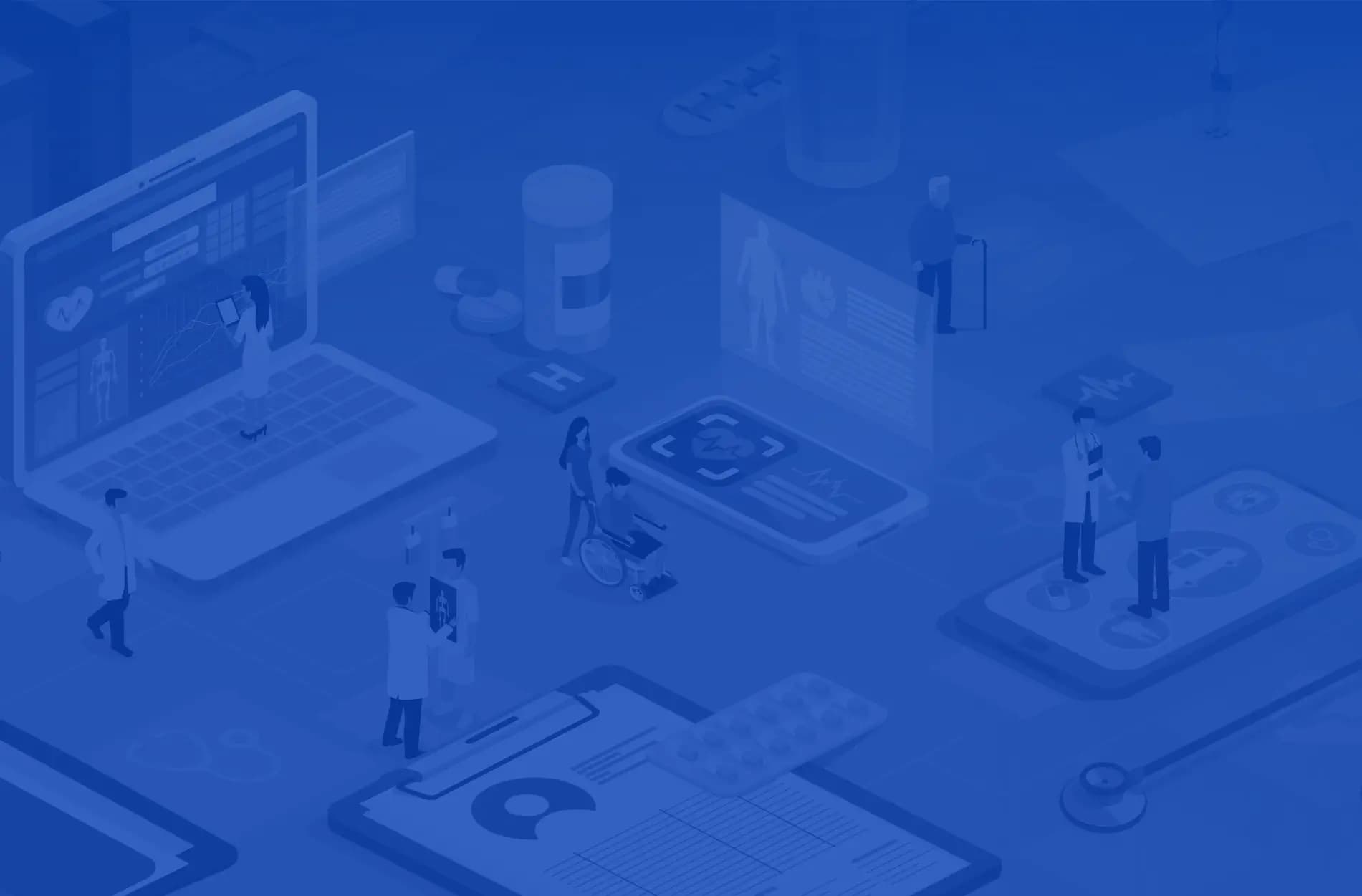
8 min read
Beyond the Pill: clinical benefits and business potential of digital health for pharma
The growing interest in digital health technologies pushes pharmaceutical companies to rapidly implement solutions that complement their traditional products. Organisations that fail to adapt to these changes risk losing their competitive edge. To succeed, pharmaceutical companies need not only innovative drugs but also exceptional experiences for patients and customers. Possible solution? Digital health technologies which offer more personalised and effective treatment methods.
Extending value across the pharmaceutical pipeline
According to the report The Global Use of Medicines 2024: Outlook to 2028 by the IQVIA Institute, global healthcare spending is projected to grow significantly, but nearly one-third of that growth will be offset by the impact of drugs losing patent protection. Specifically, older branded medicines going off-patent will face competition from generics, resulting in an estimated $192 billion reduction in spending.
Meanwhile, almost two-thirds of the global population now has internet access. More and more people around the world now have access to mobile phones, which have become an inseparable part of our daily lives. We use mobile applications widely – not only for entertainment or communication, but also to take care of our health. Increasingly, we turn to digital solutions that support physical activity, track vital parameters, or remind us to take medications regularly.
The challenges faced by pharma companies following the loss of patent protection can be effectively addressed through various digital health solutions, giving rise to a new category of therapeutics known as digital-drug combinations.
Digital-drug combination is the use of software and digital tools alongside conventional drug therapies to enhance and personalise treatment outcomes.
They support a medication throughout its entire lifecycle – from clinical trials, through its launch on the market to the point when it begins to lose value due to the arrival of generic versions and stronger competitors.
But how is it possible? Let’s get into the key value drivers of usin
How do digital-drug combinations improve treatment outcomes and patient engagement?
Around the world, the burden of chronic disease is increasing at a rapid pace. Unfortunately, most of these conditions are irreversible and need to be managed through lifelong medication use. However, many patients struggle with adhering to prescribed medications and implementing the behavioral and lifestyle changes that are needed to manage their diseases and stabilise their conditions.
Often, physicians and other healthcare providers have little ability to monitor the extent to which patients are following their recommendations and maintaining treatment regimens. As a result, disease burdens are higher than they should be.
These challenges have created a need for comprehensive disease management solutions that are best enabled by digital technologies.
Overcoming revenue barriers in pharmacotherapy
Pharmacotherapies are increasingly constrained by a range of revenue-related pressures that threaten both market performance and long-term sustainability. These include:
Intensifying competition from therapies with similar mechanisms of action, making differentiation more difficult
As the pharmaceutical industry becomes more saturated, especially within established therapeutic classes, many new products offer only marginal clinical differences. This similarity makes it difficult to achieve clear product differentiation in the eyes of prescribers, payers, and patients. Physicians may default to older, more familiar treatments or those with established payer coverage. Moreover, in competitive markets, therapeutic interchangeability leads to pricing pressures and formulary restrictions, eroding brand loyalty and compressing margins.
Low levels of adherence and persistence, which directly reduce clinical outcomes and treatment value
The burden of chronic diseases has been increasing globally and is expected to continue. Chronic diseases (such as cardiovascular disease, cancer, diabetes, and respiratory disease) were causes or contributing factors in 75% of worldwide deaths in 2010 and 79% in 2020. By 2030, experts predict that chronic diseases will contribute to as much as 84% of total global mortality.
Poor monitoring of adherence to prescribed medications undermine the management of chronic diseases. According to a 2021 global study, compliance among patients with type 2 diabetes ranges from 69 to 79%.
Yet, the McKinsey research has shown that digital disease management can drive a 45% reduction in the three-month rate of major adverse cardiovascular events (MACEs) and a 50% reduction in the 30-day readmission rates for patients after acute myocardial infarction (AMI).

These data illustrate the extent to which digital disease management can help save lives while also keeping patients healthier, which reduces costs for many stakeholders, including the patients themselves.
3. Rising pricing pressures from payers and health systems
Health systems globally are adopting cost-containment measures in response to escalating healthcare expenditures. Payers increasingly scrutinise the cost-benefit ratio of new therapies, demanding significant clinical differentiation or cost offsets. As a result, companies face greater hurdles in obtaining premium pricing, favorable formulary placement, or reimbursement without aggressive negotiation or risk-sharing agreements.
Additionally, centralised procurement, reference pricing, and external price benchmarking limit flexibility, especially in international markets. The net effect is downward pressure on average selling price and constrained revenue growth, even for clinically meaningful innovations.
4. Loss of exclusivity and patent expirations, leading to rapid erosion of market share
The end of patent protection triggers a sharp and often irreversible decline in brand revenue. Once generic or biosimilar competitors enter the market, they quickly capture significant market share due to dramatically lower pricing. Branded therapies often see price drops of 80% or more within months of loss of exclusivity (LOE), particularly in competitive markets like the U.S. or Europe.
Compounding this, payer systems frequently mandate substitution with generics or biosimilars, regardless of physician or patient preference. For companies that rely heavily on one or two flagship products, LOE events can cause severe financial disruption.
Extending drug value beyond the molecule
To overcome these barriers, pharmaceutical companies must go beyond traditional approaches. The next generation of medicines will not rely solely on active pharmaceutical ingredients. Instead, they will be enhanced by intelligent digital health tools – designed to optimise treatment outcomes, improve patient engagement, and create new forms of value across the therapy lifecycle.
So called digital-drug treatment, which integrate digital tools and software apps with traditional drug therapies, unlock new opportunities, such as:
extend product differentiation beyond the molecule,
improve adherence,
demonstrate added clinical and economic value to payers,
sustain revenue through the creation of digitally-enabled service models,
personalisation,
enhanced monitoring – provides real-time feedback on treatment outcomes, enabling quicker adjustments to therapies,
better patient engagement.
In this context, digital health is not merely a technological supplement – it is a strategic lever for restoring and accelerating the commercial viability of pharmacotherapy in an increasingly complex market landscape.
Key components of digital-drug treatment
From mobile apps that support daily medication routines to clinically validated digital therapeutics (DTx) and smart adherence platforms, digital-drugs offer a more connected, responsive, and patient-centric model of care. Let's explore the key components and benefits of digital-drug treatment.
1. Digital companion apps
Digital companion apps are mobile or web-based tools designed to support patients throughout their treatment journey. They are typically linked to a specific medication, therapy, or disease area.
Key modules of companion apps include:
Medication management module – allows users to schedule, track, and manage medication intake, reducing the risk of missed doses.
Push notifications for medication reminders – sends timely alerts to ensure medications are taken as prescribed.
Alerts for taking medications with the same active ingredient – warns users if they add drugs that contain overlapping active substances, helping to avoid overdosing or interactions.
Monitoring of package usage – tracks how much of a medication pack has been used, aiding in refills and adherence tracking.
Built-in knowledge base – provides verified educational content about conditions, treatments, and healthy living.
Ability to add notes and symptom information – allows users to log personal insights and health updates to support symptom tracking and emotional well-being.
Adding medications to user profile and treatment series – supports structured therapy planning (e.g., 14-day antibiotic course) and links drugs to individual user profiles.
Family profile database – allows caregivers to manage and monitor medications for multiple family members within the same app (especially for wound care).
Points-Based/Motivational system – encourages consistent app use and treatment adherence through gamified rewards and progress tracking.
Data collection from medical devices – integrates with smart health devices (e.g., glucose monitors, inhalers) to collect and analyse health metrics in real time.
1. Digital Therapeutics (DTx)
Digital therapeutics are clinically validated software interventions designed to treat or manage specific conditions. Also, they can be used alongside or as an adjunct to medication for diseases like depression, substance use disorders, or ADHD.
One of the examples is ABAStroke – an AI-based mobile app designed for home rehabilitation of cognitive deficits in post-stroke patients.
The app uses Applied Behavior Analysis (ABA) principles to target attention, memory, executive functions, visuospatial perception, and thinking. ABAStroke demonstrated over 84% effectiveness in cognitive rehabilitation, surpassing traditional methods (60–80% reported in the literature).
These results suggest that ABAStroke is an effective digital therapeutic tool with the potential to complement or replace traditional rehabilitation approaches. Further studies should explore long-term effects and cost-effectiveness. What’s more, it proves how game-changing digital-treatment can be.
Strengthening market position with digital companions
For pharmaceutical companies, drug-digital combinations present a compelling and timely opportunity to strengthen their therapeutic offering, secure long-term market position in an increasingly competitive healthcare landscape.
These drug-digital combinations enable pharmaceutical companies to unlock multiple strategic advantages:
Extension of the product lifecycle
By adding clinically validated digital components to existing therapies, companies can meaningfully differentiate their products even after patent expiry. This approach creates renewed market relevance and allows legacy treatments to deliver added value beyond the molecule.Increased brand loyalty and improved treatment outcomes
Personalised digital tools significantly improve the patient experience, increase engagement, and support better adherence. These factors contribute to improved real-world outcomes and deepen trust in the brand.Enhanced market access and differentiation
In competitive therapeutic areas where many drugs offer similar mechanisms of action, integrated digital support becomes a key differentiator. For payers and providers, a medicine that comes with validated digital tools for monitoring, coaching, or adherence support is seen as offering higher overall value.Improved collaboration with healthcare professionals
Digital platforms can facilitate better communication between patients and clinicians, support treatment optimisation, and reduce the administrative burden on healthcare teams.Regulatory and reimbursement advantages
Emerging frameworks, such as the FDA's Prescription Drug Use-Related Software (PDURS) and the European guidance for Software as a Medical Device (SaMD), create pathways for companies to integrate software into drug labelling and potentially influence reimbursement decisions. This regulatory evolution supports the mainstream adoption of drug-digital therapeutics.
How to introduce digital-drug combinations?
Implementing digital-drug combinations demands the right blend of technological, regulatory, and project expertise. Success in this space depends on collaboration with a partner who not only has a strong track record but also operates in compliance with recognised industry standards.
Key criteria include a certified ISO 13485 quality management system, an in-house regulatory team, familiarity with standards like IEC 82304-1, and hands-on experience in developing companion apps and digital therapeutics (DTx).
If you are looking for a partner to help you introduce digital-drug, it is worth closely examining their previous work and certification. Verify their ability to comply with necessary regulations and standards and their working system, such as whether they use an Agile methodology.
One such partner is Revolve Healthcare, an iso 13485-certified company specialising in the development of medical software and digital health solutions. We offer end-to-end support in designing and delivering digital tools that enhance patient engagement, improve adherence to prescribed therapies, and reinforce the strength of pharmaceutical brands.
Our process is built on close collaboration, adaptability, and a deep understanding of each project’s goals – from requirements gathering and UX design to development, testing, deployment, and long-term support. We are here to help you – let’s talk.




